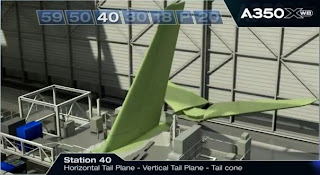In mid-2006 Airbus undertook a major review of the A350 concept.
Previously, on October/2005, full industrial launch of the A350 program was announced; a derived from the design of the existing A330 with modified wings, new engines and the same fuselage cross-section but in Al-Li.
Airbus faced almost immediate criticism on the A350 project from ILFC, GECAS and Singapore Airlines "Having gone to the trouble of designing a new wing, tail, cockpit" and adding advanced new materials, Airbus "should have gone the whole hog and designed a new fuselage."
On 14/July/2006, during the Farnborough Airshow, Airbus announced that the re designed aircraft would be called A350 XWB (Xtra-Wide-Body).
There was some previous speculation that the revised aircraft would be called the Airbus A370 or A280, with Airbus going as far as accidentally publishing an advert referring to the aircraft as the "A280" on the Financial Times website.
That's because it was reportedly only decided to name the new widebody A350XWB on monday. Untill the evening before the show at Farnborough, the choice was open between staying with the A350 name or rename it A280, and then later call the A320 successor the A180.
In China, the number 8 indicates prosperity, wealth,
success or social status. And numbers 28, 38, as eight means prosperity, twenty
eight equates to 'double prosperity', 38 being one of the luckiest, often
referred to as 'triple prosperity'.
Singapore Airlines reserves flight numbers beginning with
the number 8 to routes in China and Korea. The Air Canada route from Shanghai
to Toronto is Flight AC88. The KLM route from Hong Kong to Amsterdam is Flight
KL888.








































